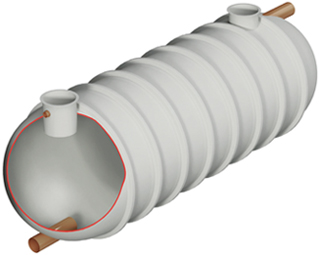If you have been looking into different kinds of sewage treatment plant for your premises, it is likely you will have come across the phrases ‘aerobic’ and ‘anaerobic’. Whilst these terms can seem rather technical to the average client, it is this distinction which will help you understand the difference between types of wastewater treatment system. Read on to find out more about these different water treatment methods.
What do ‘aerobic’ and ‘anaerobic’ mean?
If something is described as aerobic, it means that it involves the presence of air, specifically oxygen. On the other hand, anaerobic relates to something that happens in the absence of oxygen.
Anaerobic wastewater treatment
In a wastewater treatment system, anaerobic bacteria are a type of microorganism specifically used to break down the organic waste present. These organisms can work without the need for air and are widely relied on in both septic tanks and sewage treatment plants for initial sewage treatment. The process is quite slow and also creates biogases, including methane, which can result in unpleasant odours.
Advantages:
- A low amount of sludge is produced by anaerobic bacteria whilst breaking down waste
- An anaerobic system is simple and relatively cheap
- An economical treatment method with a low consumption of energy
- Great for removing high amounts of contaminants and sewage
Aerobic wastewater treatment
In aerobic wastewater treatment systems, a different kind of bacteria which need oxygen to thrive are utilised. These kinds of naturally occurring microorganisms are encouraged to grow by aerating the water in a treatment chamber, generally by means of rotating discs. This form of treatment is especially effective for removing smaller particles of soluble organic waste and, as such, it is often used as the secondary water treatment chamber in a system.
Advantages:
- Can remove smaller particles of soluble organic waste and pathogens than is possible with anaerobic treatment
- The effluent produced is of a high quality and can generally be released straight into a water course post-processing instead of having to go through more treatment processes
- The treatment process is relatively fast
- Aerobic treatment produces no odours
Due to the added complexity of the aerator needed for an aerobic system, this form of treatment inevitably comes with higher upfront and operational costs and larger space requirements.
The most effective wastewater treatment solutions will make use of a combination of both anaerobic and aerobic methods. For example, in a typical sewage treatment plant, the first chamber will be dedicated to anaerobic treatment and the second to aerobic treatment.
Wildon UK provide high quality sewage treatment solutions to customers in Stoke-on-Trent and throughout the UK. Our team of dedicated, skilled engineers can carry out work on a wide variety of wastewater systems. Whether you are in need of a professional installation or reliable maintenance and repair work from an expert, our team can deliver. Get in touch today for further information.
Go back to








